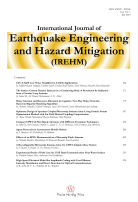


Home > Archives > Latest issue
|
International Journal of
Earthquake Engineering and Hazard Mitigation (IREHM) December 2013 (Vol. 1 N. 2) 
|
by Castorina Silva Vieira, Maria Lurdes Lopes, Laura Caldeira
Abstract - The paper presents a numerical study carried out with a two-dimensional finite difference program to model the field behaviour and the seismic response of a geogrid reinforced steep slope constructed in the North of Portugal. The reinforced slope has an extension of about 206.2 m and the reinforced soil area reaches a maximum height of about 19.6 m. The analysis of monitoring information and the numerical simulation of the construction are briefly presented. The seismic behaviour of this structure is analysed considering earthquake ground motions artificially generated. The results of the numerical simulation of the embankment construction fitted reasonably with the monitoring data. The numerical modelling of this reinforced steep slope under seismic loading showed a good performance. The residual reinforcement tensile forces remain smaller than the long term design strength of the geogrids. Since the structure is an overpass embankment, permanent vertical settlements can be the most disquieting factor. This paper is an extended version of a conference paper [1]. Copyright © 2013 Praise Worthy Prize - All rights reserved
Keywords: Reinforced Soil, Geosynthetics, Numerical Modelling, Seismic Loading.
by Y. Belmouden, P. Lestuzzi
Abstract - In this paper a planar-frame analytical model with openings is presented. The model deals with seismic analysis using the Pushover method for medium-to-short masonry buildings. Each wall with opening can be decomposed into parallel structural walls made of an assemblage of piers and a portion of spandrels. As formulated, the structural model undergoes inelastic flexural as well as inelastic shear deformations. The mathematical model is based on the smeared cracks and distributed plasticity approaches. Both zero moment location shifting in piers and in spandrels can be evaluated. The constitutive laws are modeled as bilinear curves in flexure and in shear. A biaxial interaction rule for both axial force - bending moment and axial force – shear force are considered. An event-to-event strategy is used to solve the nonlinear problem. A application was used to show the ability of the proposed model to analyze unreinforced masonry structures. Relevant findings are compared to analytical results from experimental, simplified models and finite element models using ETABS finite element package. Copyright © 2013 Praise Worthy Prize - All rights reserved
Keywords: Pushover Analysis, Unreinforced Masonry, Structural Wall, Seismic Evaluation.
by Baleshwar Singh, Birjukumar Mistri
Abstract - Plate anchors are being increasingly used as a foundation system to provide uplift resistance for several types of structures constructed both on land and offshore sites. Accurate estimation of the ultimate uplift capacity is necessary in the design to ensure the safety and stability of the supported structures. A parametric study has been carried out with finite element modeling using PLAXIS to estimate the ultimate uplift capacity of horizontal anchor plates embedded in cohesionless soils by varying soil relative density and embedment ratio. The results have been compared with those obtained from various methods and approaches which are based on theoretical, computational, physical and experimental studies. Copyright © 2013 Praise Worthy Prize - All rights reserved
Keywords: Plate Anchors, Uplift Capacity, Finite Element Analysis, Parametric Study.
by Faroudja Meziani, Amar Kahil, Smail Gabi
Abstract - Under the effect of earthquake, loss of soil stiffness results in loss of bearing capacity which subsequently lost the support of basic structures that tilt and therefore pack down. The study of settlement of granular media under seismic loading, although it has not retained the attention of many researchers in the past, is crucial if we are to guarantee the good performance of embankments, dikes or land upon which some works at risk. Numerical simulation of soil behavior is performed by numerical methods such as finite difference and finite element method. These methods are programmed in software simulation of increasingly sophisticated. The main objective of this paper is to investigate, by numerical modeling with the code of finite element PLAXIS, variation in settlement of a soil under a rock fill dam port. Copyright © 2013 Praise Worthy Prize - All rights reserved
Keywords: Compaction, Dynamic Analysis, Rockfill Dam, Effect of the Earthquake, Soil Dynamics.
by A. Kahil, M. Hamizi, N. E. Hannachi
Abstract - During these last decades, several seisms of various intensities struck several countries and caused considerable losses in human lives and significant property damages.The forecast or the estimate of the damage is an axis of the genius parasismic which gives us information on the damages which can occur. A powerful tool often used in this field provided by the curve of capacity which describes the real behavior of the structures and the damage probable which can occur by the evaluation of the point of performance based on the iterative procedure. Copyright © 2013 Praise Worthy Prize - All rights reserved
Keywords: Seisms, Nonlinear Behaviour, Curves of Capacity, PushoverAnalysis.
|